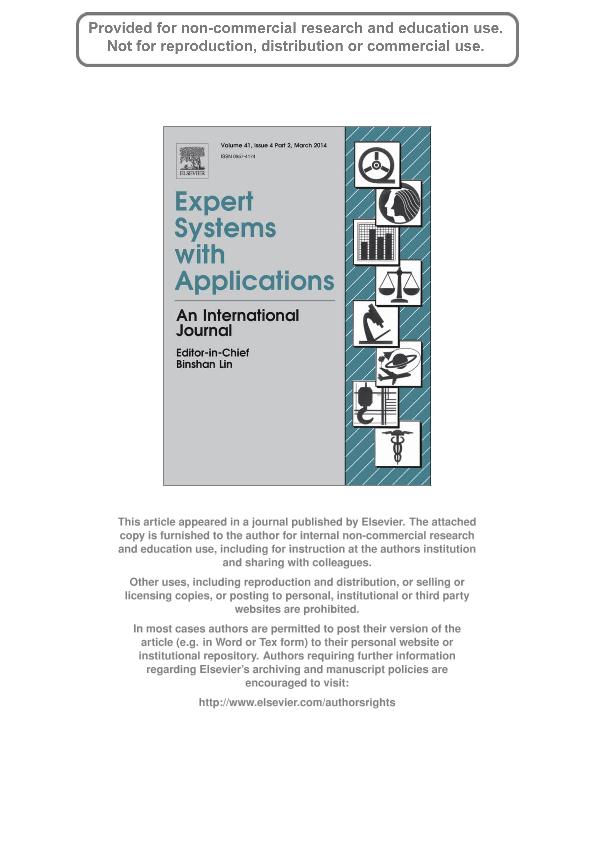Mostrar el registro sencillo del ítem
dc.contributor.author
Galli, Maria Rosa

dc.contributor.author
Reynares, Emiliano

dc.contributor.author
Caliusco, Maria Laura

dc.date.available
2016-08-03T21:14:36Z
dc.date.issued
2014-03
dc.identifier.citation
Galli, Maria Rosa; Reynares, Emiliano; Caliusco, Maria Laura; Approaching the feasibility of SBVR as modeling language for ontology development: An exploratory experiment; Elsevier; Expert Systems With Applications; 41; 4 Part 2; 3-2014; 1576-1583
dc.identifier.issn
0957-4174
dc.identifier.uri
http://hdl.handle.net/11336/6906
dc.description.abstract
Ontology development techniques still constitute an open research area despite its importance in semantic aware information systems. Until now, most methods have used UML in supporting ontology development process. Recent works propose the mapping of business rules expressions to ontology statements as a building technique by means of SBVR language. However, there is still no experimental research comparing such approaches. Aim of this work is to evaluate the feasibility of mapping business domain expressions to ontology statements. An exploratory experiment comparing performance of techniques based on UML and SBVR languages is presented. Comparison is rooted in the quality assessment of the ontologies developed by 10 equally sized groups randomly conformed by 30 undergraduate engineering students and applying such techniques. Developed ontologies largely outperform the minimally acceptable quality, according to the considered quality assessment framework. There is no statistical significant difference between the quality scores of the ontologies developed by means of UML and SBVR techniques, in any of the assessed quality dimensions. The feasibility of mapping business domain expressions to ontology statements is shown: ontologies developed by means of a SBVR based approach at least equate the quality of ontologies developed by using an UML based method. Results confirm previous research about the effectiveness of UML approaches for conceptualizing lightweight ontologies while stressing the potential of the SBVR language to express complex notions of a domain of interest. The potential of SBVR to OWL 2 mappings as an ontology development technique worthy of further study is highlighted.
dc.format
application/pdf
dc.language.iso
eng
dc.publisher
Elsevier

dc.rights
info:eu-repo/semantics/openAccess
dc.rights.uri
https://creativecommons.org/licenses/by-nc-nd/2.5/ar/
dc.subject
Ontology Development
dc.subject
Experiment Exploratory
dc.subject.classification
Ingeniería de Sistemas y Comunicaciones

dc.subject.classification
Ingeniería Eléctrica, Ingeniería Electrónica e Ingeniería de la Información

dc.subject.classification
INGENIERÍAS Y TECNOLOGÍAS

dc.title
Approaching the feasibility of SBVR as modeling language for ontology development: An exploratory experiment
dc.type
info:eu-repo/semantics/article
dc.type
info:ar-repo/semantics/artículo
dc.type
info:eu-repo/semantics/publishedVersion
dc.date.updated
2016-08-01T18:36:17Z
dc.journal.volume
41
dc.journal.number
4 Part 2
dc.journal.pagination
1576-1583
dc.journal.pais
Países Bajos

dc.journal.ciudad
Amsterdam
dc.description.fil
Fil: Galli, Maria Rosa. Universidad Tecnologica Nacional. Facultad Regional Santa Fe. Centro de Investigacion y Desarrollo de Ingenieria en Sistemas de Informacion; Argentina
dc.description.fil
Fil: Reynares, Emiliano. Universidad Tecnologica Nacional. Facultad Regional Santa Fe. Centro de Investigacion y Desarrollo de Ingenieria en Sistemas de Informacion; Argentina
dc.description.fil
Fil: Caliusco, Maria Laura. Universidad Tecnologica Nacional. Facultad Regional Santa Fe. Centro de Investigacion y Desarrollo de Ingenieria en Sistemas de Informacion; Argentina. Consejo Nacional de Investigaciones Científicas y Técnicas. Centro Científico Tecnológico Santa Fe. Instituto de Desarrollo y Diseño (i); Argentina
dc.journal.title
Expert Systems With Applications

dc.relation.alternativeid
info:eu-repo/semantics/altIdentifier/doi/http://dx.doi.org/10.1016/j.eswa.2013.08.054
dc.relation.alternativeid
info:eu-repo/semantics/altIdentifier/url/10.1016/j.eswa.2013.08.054
dc.relation.alternativeid
info:eu-repo/semantics/altIdentifier/doi/http://www.sciencedirect.com/science/article/pii/S0957417413006751
Archivos asociados
